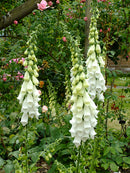Description
Digitalis purpurea 'Alba' produces striking pure white spikes of tubular flowers which look great in the border, in sun or part shade, and are very useful as a cut flower. Pure white foxgloves are elegant and simple, giving height and texture to any border as well as lightening a dark shady corner.
Most foxgloves are biennial which means that the plant grows in year one and then flowers in year two before 'setting seed' and then dying back. Those seeds will spread and make new plants and therefore new flowers and after a couple of years established this way, you'll have a garden filled with foxglove flowers. We've added this seed to our 'perennial' group for this reason.
(NOTE: they do self-seed everywhere! so when you see the new plants, dig them up and put them in the bed where you want them to grow)
The blooms are extremely attractive to bees and were awarded the RHS Award of Garden Merit (AGM).
| When to sow | Sow indoors in March to May or sow directly outdoors in May to June or September to October. |
| Where to sow | Sow indoors on the surface of moist compost filled pots or trays. Do not cover the seeds as they require light for germination. Place in a warm, light position (temperature of 18 to 24°C (64 to 75°F) is ideal). |
| Sow direct outdoors in flowering position in a well prepared seedbed. Sow seed very thinly in drills 30cm (12in) apart. Firm down gently. | |
| What to do Next | When seedlings sown indoors are large enough to handle, transplant into 7.5cm (3in) pots or trays and grow on in cooler conditions. |
| When all risk of frost has passed, acclimatise indoor raised seedlings to outdoor conditions over 7 to 10 days. Then transplant into final growing position planting them 45cm (18in) apart. | |
| Water well until plants are established. | |
| Digitalis purpurea foxgloves are biennial which means that plants establish and grow leaves in the first year, it will send up large spikes, then flower and produce seeds in the second. | |
| If you cut the main stem flower this will encourage the plant to go on flowering for longer. | |
| Flowering period | May to July (Following year). |
| Companion Planting | Extremely attractive to bees and other pollinating insects. |
| Uses | Cottage garden, perennial borders and cut flowers. |
| Height | 90 to 120cm (36-48in). |
| Spread | 45cm (18in). |
Payment & Security
Your payment information is processed securely. We do not store credit card details nor have access to your credit card information.




